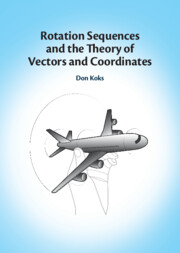Book contents
- Frontmatter
- Contents
- Preface
- 1 Setting the Scene
- 2 Trigonometry, the Foundation of Coordinate Theory
- 3 The Vector Dot and Cross Products
- 4 Vector Preliminaries and Constructing a Basis
- 5 Converting Vector Coordinates Across Bases
- 6 Vector Rotation in Two and Three Dimensions
- 7 Rotation Sequences and the Fundamental Theorem
- 8 Coordinate Systems for Earth, and More Rotation Sequences
- 9 The Role of Quaternions in Rotation Theory
- 10 Time Dependence of Vehicle Attitude
- 11 Frame Dependence of the Time Derivative
- 12 Earth’s Orientation in Space, and Time on Earth
- 13 Orbital Mechanics
- 14 Rigid-Body Dynamics
- 15 Modelling the Motion and Attitude of a Vehicle
- 16 Concepts of Tensor Analysis
- Index
12 - Earth’s Orientation in Space, and Time on Earth
Published online by Cambridge University Press: 17 April 2025
- Frontmatter
- Contents
- Preface
- 1 Setting the Scene
- 2 Trigonometry, the Foundation of Coordinate Theory
- 3 The Vector Dot and Cross Products
- 4 Vector Preliminaries and Constructing a Basis
- 5 Converting Vector Coordinates Across Bases
- 6 Vector Rotation in Two and Three Dimensions
- 7 Rotation Sequences and the Fundamental Theorem
- 8 Coordinate Systems for Earth, and More Rotation Sequences
- 9 The Role of Quaternions in Rotation Theory
- 10 Time Dependence of Vehicle Attitude
- 11 Frame Dependence of the Time Derivative
- 12 Earth’s Orientation in Space, and Time on Earth
- 13 Orbital Mechanics
- 14 Rigid-Body Dynamics
- 15 Modelling the Motion and Attitude of a Vehicle
- 16 Concepts of Tensor Analysis
- Index
Summary
Some modern implementations of vector concepts rely heavily on a precise knowledge of time. Measurements of time, both ancient and modern, have always been heavily tied to Earth’s rotation, and so this rotation must be described in detail. I begin that task by describing Earth’s orientation relative to the solar system and the stars, and use a DCM to quantify Earth’s orientation at a given moment. This introduces the idea of Universal Time, UT1. Further concepts require a short discussion of relativity, both special and general, which I do by using a balloon to describe curved spacetime. The result is UTC, our modern ‘Greenwich Mean Time’. Measuring time over long periods is made easy through the concept of the Julian day, and so I discuss the Julian and Gregorian calendars. I include a detailed example of using these ideas to calculate the sight direction of a star at some time and place on Earth.
Keywords
- Type
- Chapter
- Information
- Rotation Sequences and the Theory of Vectors and Coordinates , pp. 349 - 412Publisher: Cambridge University PressPrint publication year: 2025

